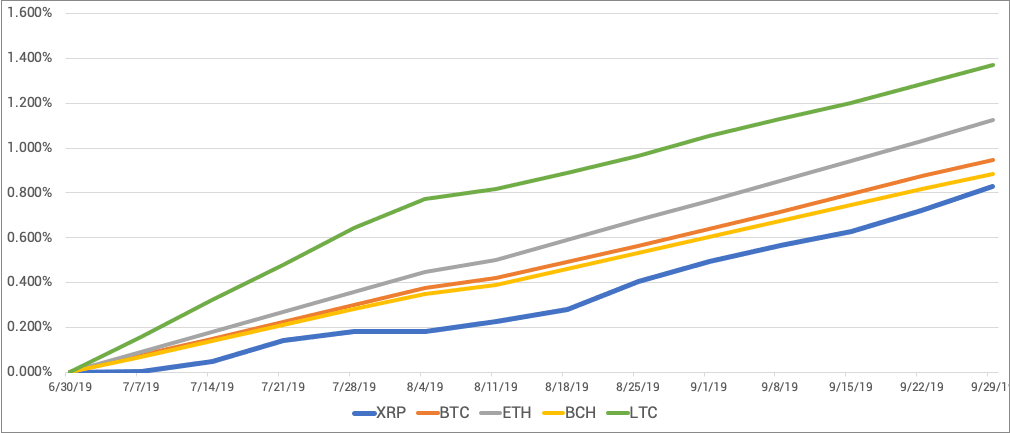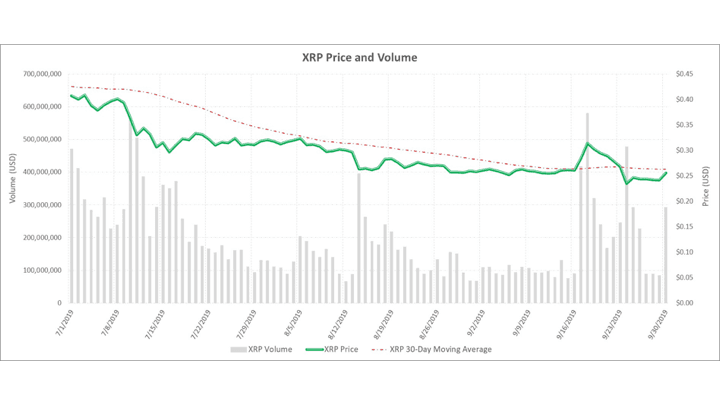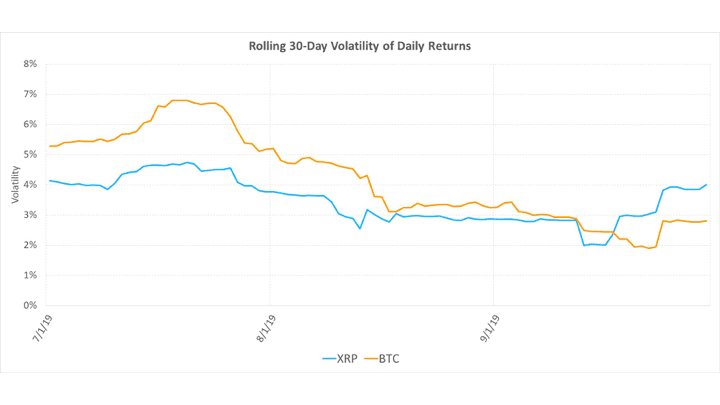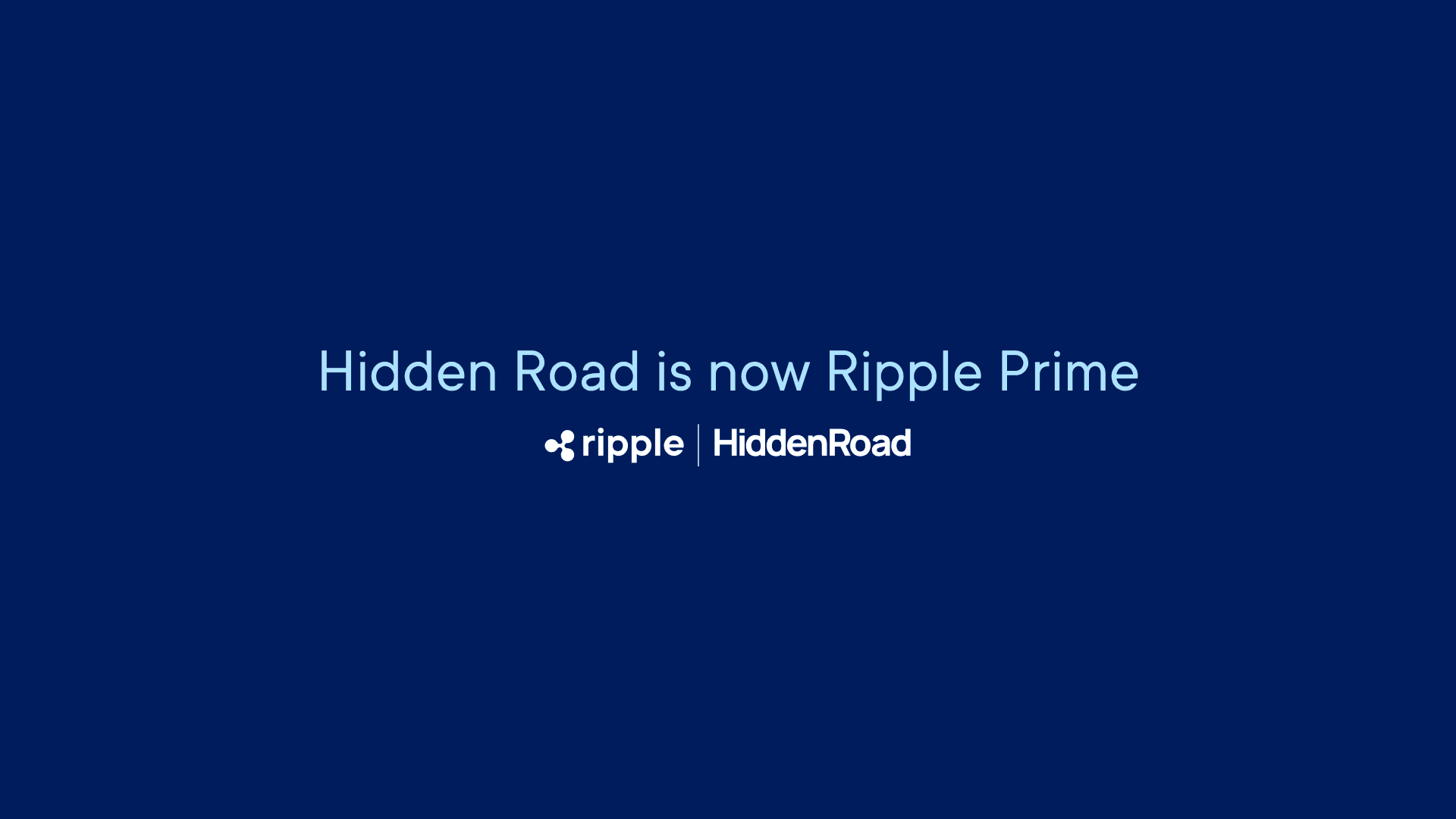Ripple publishes the quarterly XRP Markets Report to voluntarily provide unparalleled transparency and regular updates on the state of the XRP market, including quarterly programmatic and institutional sales updates, relevant XRP-related announcements such as Xpring and RippleNet partnerships, and commentary on previous quarter market developments. As an owner of XRP, Ripple believes proactive communication is part of being a responsible stakeholder. Moreover, Ripple urges others in the industry to follow its lead to build trust, foster open communication, and raise the bar industry-wide.
XRP Ledger—History
The XRP ledger is a decentralized cryptographic ledger powered by a network of peer-to-peer servers. The XRP ledger is the home of XRP, a digital asset designed to bridge the many different currencies in use worldwide. When the XRP ledger began in 2012, 100 billion units of XRP were created and no more XRP will ever be created. The available XRP supply decreases over time as small amounts are destroyed to pay transaction costs. Ripple was gifted a portion of this XRP and periodically sells a small amount of that into the market.
Decrease in XRP Sales
As readers may recall from the previous quarterly report, Ripple publicly announced our intention to shift to a more conservative volume benchmark for our XRP sales, away from CoinMarketCap and to CryptoCompare Top Tier. In the third quarter, we significantly reduced our XRP sales, consistent with the messaging we shared in the Q2 report. For Q3 19, our total XRP sales were $66.24 million vs. $251.51 million in the previous quarter. Per the Q2 report, our stated goal for programmatic sales for Q3 was approximately 10 basis points of the new volume benchmark (CCTT), and we ended sales for the quarter below that, at 8.8 bps. In fact, part way through Q3, we decided to pause programmatic sales altogether, and focus our over-the-counter (OTC) sales on a few strategic partners, who are building XRP utility and liquidity in regions that are strategically important to our growing global business, including EMEA and Asia. Total sales including OTC and programmatic ended the quarter at 36 bps of CCTT.
As a result of this discipline, Ripple’s XRP distribution rate since the beginning of the quarter has been lower compared to the inflation rates of ETH and LTC, and similar to BTC – see chart below.

Source: Coinmarketcap and internal data
NOTE: No new XRP can ever be created post the Genesis block, so XRP actually has a slight negative inflation rate due to the destruction of XRP related to transaction fees. Therefore, the line above reflects Ripple’s distribution of XRP, but not the asset’s inflation rate.
Q3 Highlights
- Ripple sold $66.24 million XRP in Q3 2019, a 73.7% decrease in sales in XRP QoQ, as measured in USD.
- Overall market capitalization of digital assets decreased in Q3, with the overall market cap losing 30.4%. XRP price declined 35.4% QoQ.
- Three billion XRP were released out of cryptographic escrow, 2.30 billion XRP were returned to escrow.
- XRP is now listed on over 140 exchanges worldwide.
| Sales Summary (dollars in millions) | Q2 2019 | Q3 2019 |
|---|---|---|
| Institutional direct sales | 106.87 | 50.12 |
| Programmatic sales | 144.64 | 16.12 |
| Total sales | 251.51 | 66.24 |
| Global XRP volume | Q2 2019 | Q3 2019 |
|---|---|---|
| ADV XRP (dollars in millions) | 429.51 | 198.10 |
| Total XRP volume (dollars in billions) | 39.09 | 18.23 |
| Total sales as % of total volume | 0.6% | 0.4% |
Looking ahead to Q4, we will continue to monitor volume developments closely and intend to maintain a similar approach to Ripple’s XRP sales as compared with Q3.
Volume
CCTT’s reported daily volume for XRP decreased in Q3 from the previous quarter. The average daily volume was $198.10 million in Q3 versus $429.51 million in Q2, though higher than $156.01 million in Q1.

Volatility
Based on CCTT’s reported volume, XRP’s volatility of daily returns over the quarter was 3.6%, which is lower than the previous quarter’s 5.0%. XRP’s volatility was lower than that of other top digital assets, as BTC’s volatility of daily returns through Q3 was 3.9% and ETH’s was 4.3%.

Q3 Escrow Activity
In Q3 2019, three billion XRP were again released out of escrow (one billion each month). 2.30 billion XRP were returned and subsequently put into new escrow contracts. The majority of the unused portion of the 700 million XRP not returned to escrow was being held in operating wallets at the end of the quarter. All figures are reported based on transactions executed during the quarter.
Spread of Misinformation
Last quarter, there was an uptick in FUD (fear, uncertainty and doubt) and the spread of misinformation about XRP, especially around topics such as purported XRP dumping and price manipulation by Ripple. FUD is a tool typically used to undermine new technologies. Due to the nature of digital asset markets, FUD runs rampant, often perpetrated by those with political or financial interests in certain cryptocurrencies. Healthy dialogue, transparency, and pragmatism are vital to dispel misinformation, properly educate the market, and foster innovation in our industry.
Though Twitter is not the only place where FUD persists, bots on Twitter (accounts with high indication of automated publishing activity, based on Indiana University research) contributed to the propagation of FUD across the digital asset industry. They comprised 49% of the share of conversation about BTC, 71% about ETH and 50% about XRP1
In Q3, bots have been more active in conversations around XRP, with the number of unique bots rising and engaging in messages related to:
FUD #1: Dumping allegations
- Conversation from bots specifically about Ripple “dumping XRP” and “flooding the market,” increased 179% quarter over quarter.
- “Dumping” allegations were the most common FUD topic of conversation in recent months compared to others.
Truth:
- Conversations attempted to support the allegations by pointing to large movements of XRP, which were in fact transfers between Ripple treasury and escrow management accounts. In other words, those transfers did not entail Ripple distributing XRP.
- Critics further focused conversation on the fact that large XRP holders exist—referred to as “whales.” Large holders exist in many digital asset communities such as bitcoin and ether. We do not see evidence that large holders of XRP are behaving materially differently than BTC or ETH “whales.”
FUD #2: Price Manipulation
- Nearly half (49%) of all conversations alleging Ripple “made XRP price fall” came from bot accounts.
Truth:
- Bottom line—Ripple cannot control XRP price. XRP is traded on a fully functioning and independent digital asset market, including over 140 exchanges, in which Ripple plays a very limited role.
- XRP exists independently of Ripple. The XRP Ledger is a free, open-source, decentralized technology. Others can and do develop on it and use it. If Ripple went away tomorrow, the Ledger would continue to exist and XRP would continue to trade.
- As a stakeholder of XRP, Ripple is an interested party in its success. We are aligned with other XRP stakeholders and focused on supporting a healthy XRP community.
While misinformation persists across all markets and news topics, as this industry matures, we believe conversations about the use cases, commercial traction, and human impact of digital assets will dominate. We support the many industry players focused on real utility regardless of token association. It’s on all of us to rise above the FUD and the tone-deaf who treat digital assets like a religion instead of technologies that can solve real world problems.
RippleNet On-Demand Liquidity (ODL) / XRapid
Ripple continues to experience high customer demand for On-Demand Liquidity (formerly known as xRapid), which leverages XRP to source liquidity for cross-border transactions, enabling instant settlement and more efficient use of working capital.
XRP is ideally suited for global payments because it is faster, less costly and far more scalable than other digital assets.
Here is a quick snapshot of XRP vs. bitcoin (as of 10/14):
- Speed: 3.80 seconds (XRP) vs. 9.2 minutes (BTC)
- TPS: 1500+ (XRP) vs. 7 (BTC)
- Fee: $0.0003 (XRP) vs. $0.758 (BTC)
While bitcoin’s utility is often highlighted as a store of value, we believe XRP is by far the best digital asset for global payments.
Ripple customers live with ODL, including MoneyGram and others, increased by 75% last quarter and dollar volume on ODL increased more than five times from Q2 to Q3. In addition, Ripple announced its acquisition of team Algrim to support the ongoing development of ODL. To keep up with strong customer demand, Ripple is rapidly expanding its team on a global scale—Iceland will serve as one of Ripple’s engineering hubs with plans to bring on more technical talent in Europe.
Xpring
Last quarter, Ripple announced Xpring’s new developer platform to make it easier for developers and entrepreneurs to build on the XRP Ledger and use XRP. The platform leverages open-source technologies, protocols and networks making it easy for the 23 million developers worldwide to enable payments in their products and services.
Of note, Ripple acquired Logos to add to the Xpring team. This team will focus on decentralized financial (DeFi) projects and explore a system that will leverage XRP at its core, as well as other ideas to update digital assets to transform payments and finance. Xpring continues to see innovation in new use cases such as trading, micropayments for content, and gaming. Other notable traction and news from Q3 include:
- Xpring invested in Coinme, a global leader in cryptocurrency ATMs and blockchain financial services, to advance the adoption of cryptocurrencies, such as XRP.
- Coil, a streaming micropayments tool that uses the Interledger Protocol (ILP) and any currency, including XRP, partnered with Mozilla and Creative Commons to launch Grant for the Web.
- Bitpay partnered with Xpring to natively support XRP, which will enable thousands of businesses to accept XRP for payments.
Market Commentary
Notable Regulatory Activity
- UK’s Financial Conduct Authority (FCA) issued guidance to clarify definitions and domains for different crypto assets. They recognize ETH has the features of a hybrid exchange and utility token (not a security token). The FCA has previously called out the similarities between ETH and XRP, and noted in a press release that XRP would not be regulated as a security.
Industry Player Moves
- Blockstack’s token sale became the first SEC-qualified offering in U.S. history.
- Visa, Mastercard, Mercado Pago, Booking Holdings, PayPal, eBay, and Stripe reconsidered their involvement in the Libra consortium.
- SWIFT launched a new API standard for pre-authorization of funds which will allow a payer’s bank to guarantee funds in advance of a payment.
- The Federal Reserve Bank announced “FedNow,” a new service that will allow all banks in the United States to offer 24/7 real-time payment services.
- Mastercard acquired the account-to-account capabilities of Nets to further develop its real-time payments capabilities.
Conclusion
Q3 was marked by continued discipline around Ripple’s XRP sales and significant traction for XRP in both RippleNet’s ODL offering as well as the expanding developer community. These activities underscore the continued maturation of digital asset markets. Ripple will continue to take proactive steps to address misinformation and FUD while being a responsible and transparent stakeholder of XRP.
If interested, please find the Q2 2019 XRP Markets Report here.
---
1 Statistics are sourced via publicly available Twitter posts from July 1 to September 30, 2019, in partnership with Methods+Mastery.







